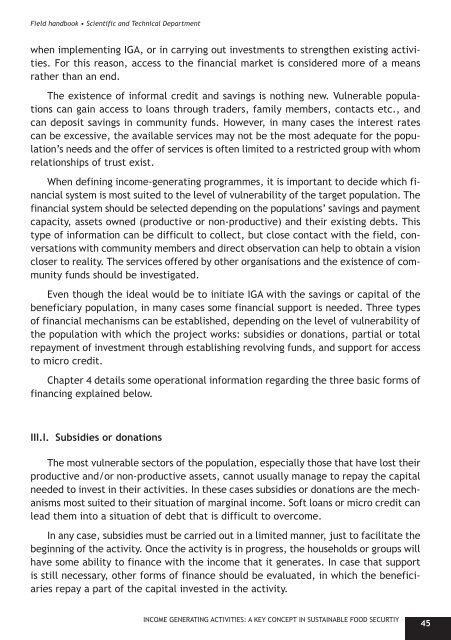Income-Generating Activities - Action Against Hunger
Income-Generating Activities - Action Against Hunger
Income-Generating Activities - Action Against Hunger
You also want an ePaper? Increase the reach of your titles
YUMPU automatically turns print PDFs into web optimized ePapers that Google loves.
Field handbook • Scientific and Technical Department<br />
when implementing IGA, or in carrying out investments to strengthen existing activities.<br />
For this reason, access to the financial market is considered more of a means<br />
rather than an end.<br />
The existence of informal credit and savings is nothing new. Vulnerable populations<br />
can gain access to loans through traders, family members, contacts etc., and<br />
can deposit savings in community funds. However, in many cases the interest rates<br />
can be excessive, the available services may not be the most adequate for the population’s<br />
needs and the offer of services is often limited to a restricted group with whom<br />
relationships of trust exist.<br />
When defining income-generating programmes, it is important to decide which financial<br />
system is most suited to the level of vulnerability of the target population. The<br />
financial system should be selected depending on the populations’ savings and payment<br />
capacity, assets owned (productive or non-productive) and their existing debts. This<br />
type of information can be difficult to collect, but close contact with the field, conversations<br />
with community members and direct observation can help to obtain a vision<br />
closer to reality. The services offered by other organisations and the existence of community<br />
funds should be investigated.<br />
Even though the ideal would be to initiate IGA with the savings or capital of the<br />
beneficiary population, in many cases some financial support is needed. Three types<br />
of financial mechanisms can be established, depending on the level of vulnerability of<br />
the population with which the project works: subsidies or donations, partial or total<br />
repayment of investment through establishing revolving funds, and support for access<br />
to micro credit.<br />
Chapter 4 details some operational information regarding the three basic forms of<br />
financing explained below.<br />
III.I. Subsidies or donations<br />
The most vulnerable sectors of the population, especially those that have lost their<br />
productive and/or non-productive assets, cannot usually manage to repay the capital<br />
needed to invest in their activities. In these cases subsidies or donations are the mechanisms<br />
most suited to their situation of marginal income. Soft loans or micro credit can<br />
lead them into a situation of debt that is difficult to overcome.<br />
In any case, subsidies must be carried out in a limited manner, just to facilitate the<br />
beginning of the activity. Once the activity is in progress, the households or groups will<br />
have some ability to finance with the income that it generates. In case that support<br />
is still necessary, other forms of finance should be evaluated, in which the beneficiaries<br />
repay a part of the capital invested in the activity.<br />
INCOME GENERATING ACTIVITIES: A KEY CONCEPT IN SUSTAINABLE FOOD SECURTIY<br />
45

















